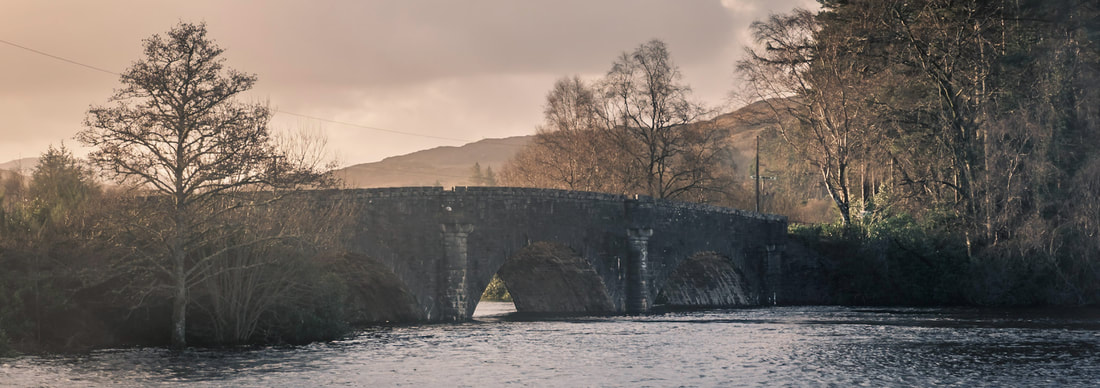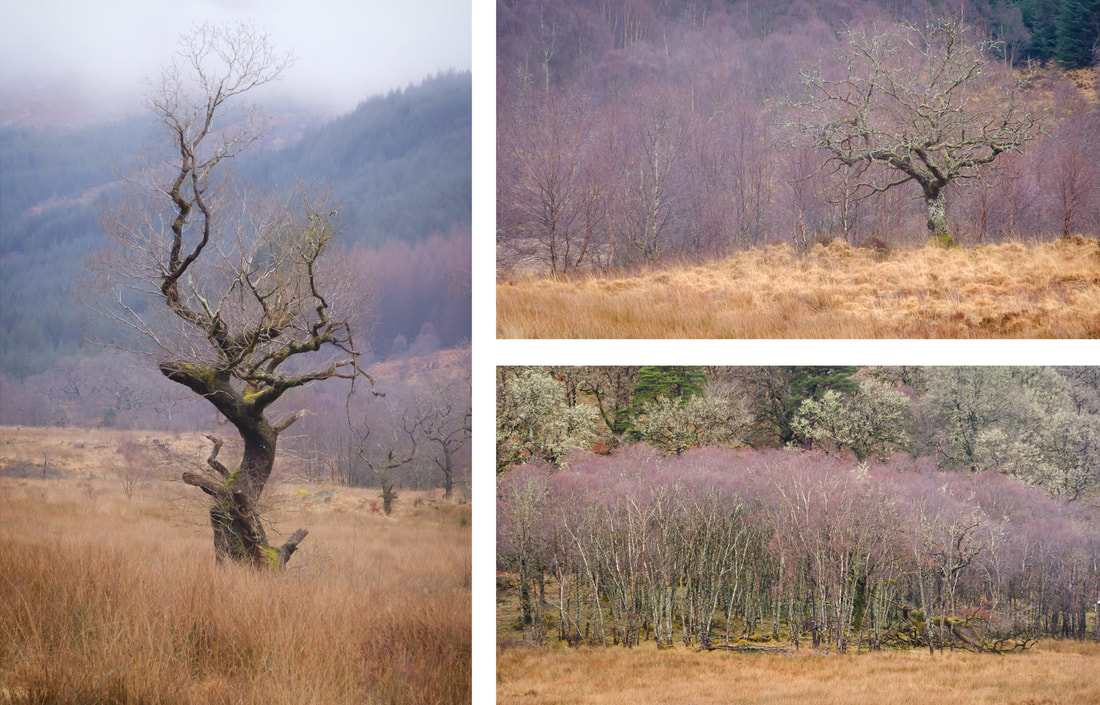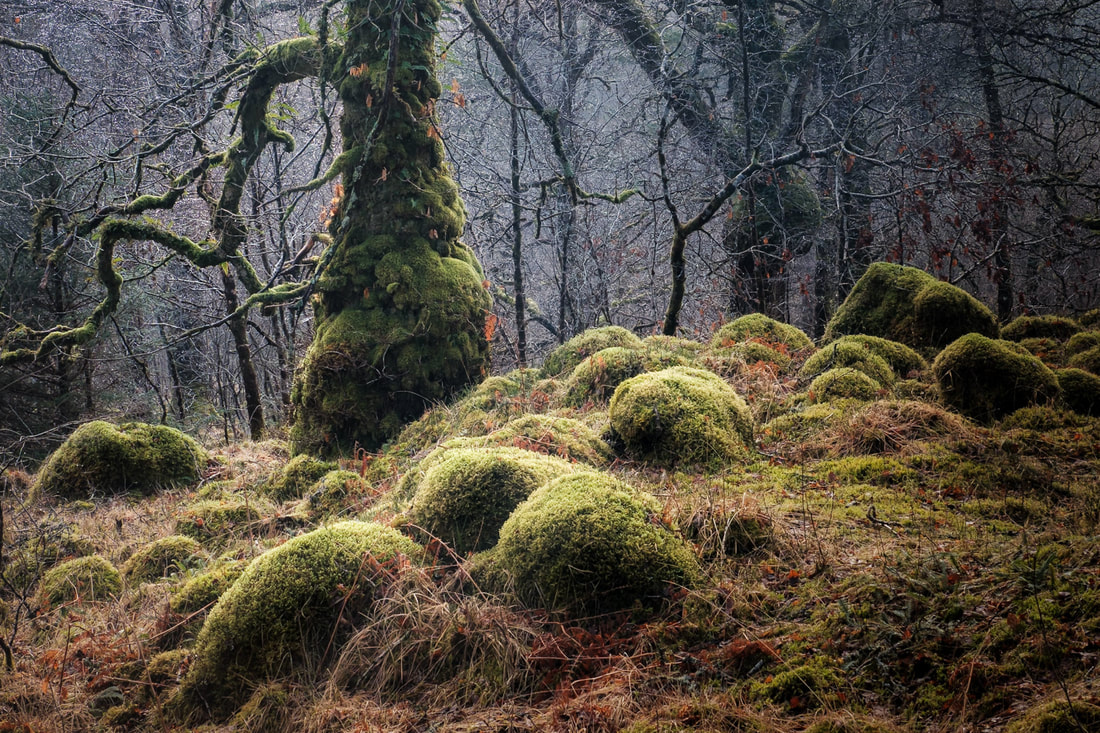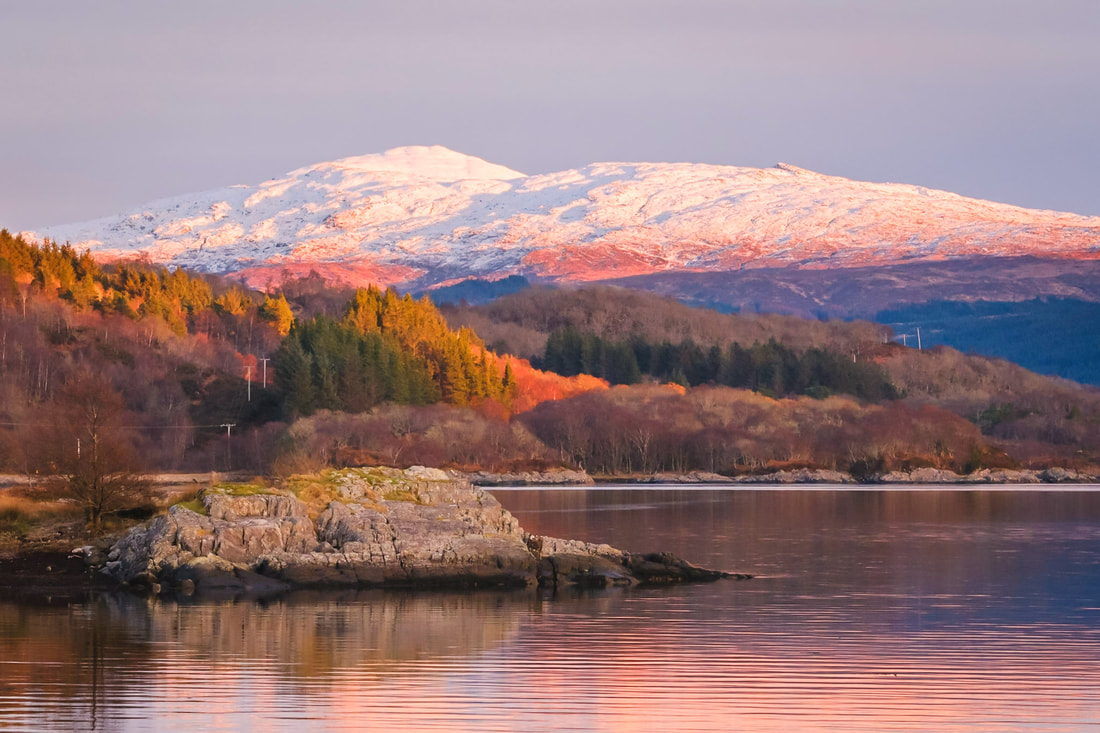|
After some lovely weather in May, which turned the woodlands around Loch Sunart that intense ‘spring green’ colour that featured in last month’s Viewfinder Vignette blog, things turned decidedly cold and grey in June. However, the wildflowers fought through the gloom to bring splashes of colour to places around the Peninsula and occasional breaks in the weather gave us one or two beautiful midsummer sunsets. The start of the month was particularly cold wet and grey, making it challenging for me to motivate myself to get out with the camera. However, my cocker spaniel Fergus needs walked whatever the weather and, more often than not, I take a camera with us when we head out on our daily wander. One walk took us to Sailen nan Cuileag, a bay to the east of Salen on Loch Sunart and while Fergus and his nose explored the shoreline, I sat on a rock, watched yachts leaving their overnight mooring in Salen Bay and took a few photographs of them as they were carried down the Loch by a light north westerly breeze.
As the days passed, the cold, grey and dull conditions persisted, so my outings continued to be limited to when Fergus and I were out on walks. One day, when we were at Kentra Bay at low tide, making the most of running about the vast sands (Fergus, not me!!) that appear when the bay empties, I spotted a lone sea urchin shell sitting amongst the sea pinks that cover the salt marsh there in June. I didn’t have my camera with me, so I made a mental note of the location and decided to come back in the evening to photograph it because the forecast was for the cloud to clear a little. However, when returned that evening, the clouds remained and the light that I was hoping for was not there. Nevertheless, I took a few shots of the sea urchin shell, some close up and some of the wider view before eventually deciding that my favoured composition was of it sitting amongst the sea pinks in the foreground with Ben Resipole under an imposing, cloud filled sky as a backdrop. The drive home from there takes me through Acharacle and past a tin shed that sits at the end of a croft field. It is something that I have driven by countless times, but on this occasion, a thick blanket of bright yellow buttercups that covered the field caught my eye and drew my attention to the contrasting colours of the tin shed. The sight of this beautifully colourful scene was most welcome on such a dull grey evening, so I turned the van around, found somewhere to park and took a few photographs of it. As the month progressed, one thing that has struck me this year was the number of foxgloves that were appearing. Their tall purple spires of bell shape flowers seemingly rising above every dense blanket of bracken that I have come across. Their size and colour make them visually striking plants and provide ideal subjects with which to anchor your composition and I used them for to this effect at Castle Tioram and Camas nan Geall . My final photography outing of the month took me to Samalaman Bay near Glenuig on an evening when the sun eventually made an appearance. To make the most of this, I decided to spend a few hours there to watch the tide go out and the sun go down. When I arrived, the sun was still reasonably high in the sky, so I focussed my attention on an upturned row boat that seems to have taken up a long term residence amongst the water lilies there. I started with wider shots of the boat and the bay with the jagged peaks of the Isle of Rùm in the distance before turning my attention to some close-up shots of the boat and the lilies. Worryingly, cloud began to roll in from the east as sunset approached but I remained hopeful that there would be a sufficient gap between the clouds and the western horizon to allow the sun to cast some light on the landscape. I wasn’t disappointed because eventually the sun dipped below the clouds and bathed the sands that had been uncovered by the falling tide with a beautifully warm and golden light. I photographed the bay and the sands until the sun dropped behind the Small Isles of Eigg and Rùm before taking a final shot of these islands silhouetted against an intensely orange coloured sky. I left Samalaman Bay satisfied with what I had captured and with the thought that this must be one of the best places on the Peninsula to experience a midsummer sunset. On the way home the following morning, I stopped off at Ardmolich at the head of Loch Moidart to photograph a vast swathe of cottongrass that had caught my eye on the drive out to Glenuig. This plant is actually not a grass, but a sedge and it thrives in acidic, waterlogged soil such as that found there. It’s distinctive white, fluffy seed heads covered the ground, providing me with plenty of photographic opportunities and a productive stop with which to end my last photo trip of the month.
2 Comments
May is one of my favourite months of the year because it is the month in which the landscape well and truly awakens from its winter slumber. This was certainly the case this year because the intense ‘spring green’ colour that is such a potent sign of new life arrived in its full splendour to adorn the woodlands at the top end of Loch Sunart during the first week of the month, compelling me to go out and capture a small piece of this beautiful and vibrant sight. My first outing took me to Phemie’s Walk near Strontian and to my favourite place in the woods there. It is a place well off the path where a stand of magnificent birch trees creates an almost cathedral like space and on the morning I was there, their leaves were backlit to create an incredibly iridescent canopy that covered the space around me and tinged the trunks and branches of the trees with a beautiful green hue. A couple of weeks later and the leaves on the ancient oak trees that cover the hillside around my house at Resipole had well and truly made their spring entrance as well. This, along with the greening up of the previously dry and russet scrubland, had turned this part of Sunart into a verdant oasis and provide me an opportunity to use the drone to capture the ‘spring green’ from a different perspective. After capturing the panoramic view of the verdant oak trees that cover the hillside to the west of the house and Ben Resipole, I turned the drone to face the other direction down to Loch Sunart and the rocky shoreline down to where the oakwood stretches. It was late in the evening and some beautifully soft light from the low Sun was such that it accentuated the shapes of the trees to provide the perfect opportunity to take some top-down shots showing the interplay between the oak wood, the rock and the sea. One of the things that always fascinates me, when I’m flying the drone above the oakwoods with the camera facing downwards, is how distinct each of the trees can be. When you’re on the ground looking up through the tree canopy it seems to blanket the entire sky, yet looking down, reveals gaps and lines where the trees seem almost afraid to touch each other. This is a phenomenon called ‘crown shyness’ which is thought to be caused by the trees detecting a frequency of visible light called far-red light, which can tell them how close they are to their neighbours. When they sense they are close, they stop growing and thereby maintain their exposure to light and optimise the process of photosynthesis. I had a second outing with the drone in the hope of capturing more soft evening light on the trees, but this time around the bay that is Sàilean nan Cuileag, a mile or so east of Salen. However, despite the conditions looking hopeful, cloud rolled in from the northeast meaning that I had to content myself with a couple of shots of the bay that were more subdued that I had envisaged. Both images show the bay at high tide, filled with seawater and therefore at its most attractive for ariel photography. The first is looking out of the bay, southwest down Loch Sunart, while the second is looking northeast into the bay and back towards Ben Resipole and is perhaps my favourite image from the month, probably because I feel it captures so much of a place I’m lucky to be able to call home.
February, the last month of meteorological winter, proved to be less stormy than January but what it lacked in wind was certainly made up in rain. Looking at my weather station, it was the second wettest February I’ve experienced since moving to the Peninsula in 2016, with almost 200mm of rain in the month, and over half of that falling in the first week. The sheer volume of rain falling onto already saturated ground over such a short period of time meant that both the River Shiel and Loch Shiel were as high as I’ve ever seen them. I was keen to record this, so I headed up to the bridge that crosses the River Shiel just to the north-west of Acharacle to see what I could photograph. On the morning I was there, the rain had eventually stopped and the rising sun occasionally shone through the breaks in the cloud that were beginning to appear. This first image I took were of the bridge silhouetted against the warm morning light and I then turned my attention to picking out some of the trees downstream of it, that were sitting submerged in a few feet of water. A couple of mornings later, I returned to Acharacle, but rather than photographing the bridge again, I decided to focus on Loch Shiel and the submerged fences that were in the flooded fields close to the Shielbridge Hall in the centre of the village. I was there just before sunrise, hoping for some colour to appear in the sky but high-level cloud cover prevented this and instead the landscape was bathed in some beautifully subtle, soft and warm light. This was perfect for the shots I ended up taking. Upon finishing exploring the submerged fence posts, my attention turned to the various patches of ice that had formed along the water’s edge as a result of overnight sub-zero temperatures. Indeed, I was very appreciative of my liner gloves and woollen mitts, packed with charcoal hand warmers, which were keeping my fingers warm while the mercury still hovered around the -2°C mark. There were some fascinating wafers of ice suspended above the surface of the loch by tussocks of grass, presumably left because the water level in the loch was falling now that the rain had stopped for a couple of days. As well as these suspended wafers of ice, the curving water's edge near the Shielbridge Hall played host to a myriad of intricately frosted blades of grass that formed the boundary between the frozen field and the frozen loch. They were a joy to photograph. The middle of the month was dominated by misty, grey days which are best described as being “smirry”. You see, “smirr” is an Old Scots word for a delicate form of rain or a misty drizzle that lingers in the air and that’s certainly what we had. On days like that, woodlands are a good place to go for taking photos, so I decided to take my camera on a wander around the 4km loop at Ariundle Oakwood which takes you up the side of the Strontian River and back down through the ancient oaks that can be found there. Despite the greyness of the day, there was still some colour to be found as my eye was drawn to the contrasts between the orange hues of the winter undergrowth, the purple tinge of the bare branches of stands of silver birch trees and the silvery grey of the lichen covered branches off the gnarly oak trees. However, as always, the thing that catches my eye most when I take a walk through the oakwoods is the combination of thick and twisted oak tree trunks and branches surrounded by large and rounded moss covered boulders. There’s something quite enchanting about this sight and I think that it is little wonder that folklore has it that the boulders are home to faeries that live in the woods. My next outing with the camera took me to Sàilean nan Cuileag, a small bay on Loch Sunart, just to the east of Salen. It’s not far from my house, so it is a place I often take the dog for a walk and on the countless times I’ve been there I’ve crossed a small stream that cuts across the path on the way down to the bay. I’ve never paid much attention to it but on this occasion, I stopped and spent some time taking some close-up shots of the water flowing over the red tinged stones that can be found in the streambed. I had never noticed them before, so the experience reminded me of what you can see if you take the time to slow down and really look at something. After photographing the streambed, I continued my walk down to the bay with the intention of photographing the stream as it flowed into the sea at high tide. I took a few shots of the scene I had in my mind, but the dullness of the evening meant that I didn’t get anything I was happy with. Instead, I turned my attention to taking some close-up shots of the trees that fringe the bay. They comprise a mixture of larch and oak, whose bare branches were covered with silvery grey lichen just like those I photographed at Ariundle Oakwood a week or so earlier. From all of the images above, you will see that February has been quite a grey and colourless month, but thankfully as both the end of the month and the end of meteorological winter approached, the weather began to improve and we were treated to a couple of colourful sunsets. During one of these, I was looking eastwards, out of the kitchen window, just as beautifully warm light fell on a snow capped Fuar Bheinn, a 2514-foot-high Corbett that is one of a horseshoe of peaks that circles Glen Galmadale over on Kingairloch Estate. It was such a beautiful sight, so I just had to grab my camera, rush outdoors and capture the scene before the light disappeared as the sun dipped below the hills behind and to the west of me. After this, I stayed by the loch side for a while and watched the colours of the loch, sky and landscape change as the sun set and took the following image which shows the view looking westwards down Loch Sunart from Resipole. This rich orange glow of a late winter sunset was a perfect and spectacular end to a month, which for the most part, had been a dull and grey one.
|
AuthorHi, I’m Steven Marshall, a Scottish landscape photographer based at Rockpool House in the heart of the beautiful West Highland Peninsulas of Sunart, Morvern, Moidart, Ardgour and Ardnamurchan. Categories
All
Archives
June 2024
|
Steven Marshall Photography, Rockpool House, Resipole, Strontian, Acharacle, PH36 4HX
Telephone: 01967 431 335 | Mobile: 07585 910 058 | Email: [email protected]
Telephone: 01967 431 335 | Mobile: 07585 910 058 | Email: [email protected]
All Images & Text Copyright © 2024 - Steven Marshall - All Rights Reserved
































